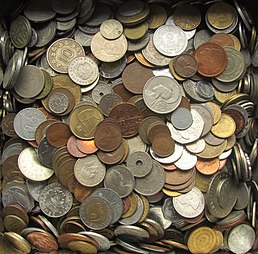
Back Moneda AN Mynet ANG نقود معدنية Arabic Moneda AST Sikkə Azerbaijani Münze BAR Манета Byelorussian Манэта BE-X-OLD Монета Bulgarian Moneda (peça de metall) Catalan
| Part of a series on |
| Numismatics the study of currency |
|---|
 |
A coin is a small object, usually round and flat, used primarily as a medium of exchange or legal tender. They are standardized in weight, and produced in large quantities at a mint in order to facilitate trade. They are most often issued by a government. Coins often have images, numerals, or text on them. The faces of coins or medals are sometimes called the obverse and the reverse, referring to the front and back sides, respectively. The obverse of a coin is commonly called heads, because it often depicts the head of a prominent person, and the reverse is known as tails.
The first metal coins – invented in the ancient Greek world and disseminated during the Hellenistic period – were precious metal–based, and were invented in order to simplify and regularize the task of measuring and weighing bullion (bulk metal) carried around for the purpose of transactions. The carryied their value within the coins themselves, but the stampings also induced manipulations, such as the clipping of coins to remove some of the precious metal.[1]
Most modern coinage metals are base metal, and their value comes from their status as fiat money — the value of the coin is established by law. In the last hundred years, the face value of circulated coins has occasionally been lower than the value of the metal they contain, primarily due to inflation. If the difference becomes significant, the issuing authority may decide to withdraw these coins from circulation, possibly issuing new equivalents with a different composition, or the public may decide to melt the coins down or hoard them (see Gresham's law). Currently coins are used as money in everyday transactions, circulating alongside banknotes. Usually, the highest value coin in circulation (excluding bullion coins) is worth less than the lowest-value note. Coins are usually more efficient than banknotes because they last longer: banknotes last only about four years, compared with 30 years for a coin.[2][3]
Exceptions to the rule of face value being higher than content value currently occur for bullion coins made of copper, silver, or gold (and rarely other metals, such as platinum or palladium), intended for collectors or investors in precious metals. Examples of modern gold collector/investor coins include the British sovereign minted by the United Kingdom, the American Gold Eagle minted by the United States, the Canadian Gold Maple Leaf minted by Canada, and the Krugerrand, minted by South Africa. While the Eagle and Sovereign coins have nominal (purely symbolic) face values, the Krugerrand does not. Commemorative coins usually serve as collectors items only, although some countries also issue commemorative coins for regular circulation.
- ^ Sancinito, Jane E. “Like a Bad Penny: Ancient Numismatics in the Ancient World.” Expedition: The Magazine of the University of Pennsylvania Museum of Archaeology and Anthropology 60, no. 2. (2018): 12-23: "The first people to use coins were from modern Turkey, right around 600 BCE. Their coins were different from ours today, less regular and made from precious metal, a mix of gold and silver known as electrum, but their experience, as they went to market or paid their taxes, was similar to mine in the coffee shop. They looked at the lumps of metal in their hand and tried to figure out how much money they had left, and whether they had been cheated. Current research suggests that coins were invented to simplify and regularize this task. Amounts of metal were measured to specific levels of purity and then stamped with an official mark, thereby speeding up transactions and, for the first time in history, guaranteeing certain pieces of metal were trustworthy. The idea caught on quickly, spreading through Western Asia Minor before being adopted by the city-states of Archaic Greece.”
- ^ U.S. Currency: Financial Benefit of Switching to a $1 Coin Is Unlikely, but Changing Coin Metal Content Could Result in Cost Savings
- ^ Lawmakers (again) propose replacing $1 bills with coins
